The A’s were the first dynasty in the American League. At that time the franchise was in Philadelphia, where they had three stretches of dominance and won five championships.
This list ranks the 20 greatest players in franchise history based on their years with the A’s only, according to Wins Above Replacement (from Baseball-Reference.com).
This list is not meant to be a definitive ranking of the best players to have played for the franchise. It’s a subjective list based on bWAR. Why do we use bWAR? Because it makes it easy to put the lists together. The real reason I write these articles is to comment on these players.
This is one in a series of articles on the 20 Greatest Players for Each MLB Franchise.
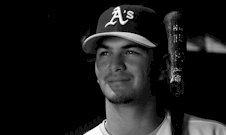
Chavez was a dirt dog, one of those players who got on the ground, got his uniform dirty every day. He was an excellent defender, basically every year that he played regularly at third he won a Gold Glove award. You could make a case for him as the best defensive third baseman at his peak since Mike Schmidt or maybe Terry Pendleton. He could really pick it and had a tremendous arm until back injuries slowed him. Chavez hit 227 homers before the age of 30, but only 33 after.
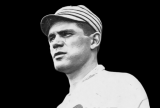
In mid-career, Mack moved Danny Murphy from second base to right field to make room for young college-educated Eddie Collins. Some in the A’s clubhouse didn’t like the move, but Murphy wasn’t bitter. “He willingly cooperated with me,” Collins later recalled, “I took to the position naturally and really found myself there, but Murphy played a great part in helping mold me into a good infielder, or rather a good second baseman.” The A’s kept winning, capturing pennants in 1910, 1911, and 1913.
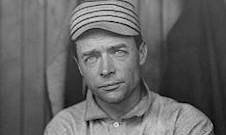
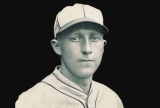
In Philly, manager Connie Mack wrote Maxie Bishop’s name in at the top of his order and watched as his little second baseman averaged 130 walks a season. The redhead scored oodles of runs ahead of Mickey Cochrane, Al Simmons, and Jimmie Foxx. He was so good at drawing walks that he was called “Camera Eye.” After he retired, Bishop coached the Naval Academy baseball team for a quarter of a century. The field at the Naval Academy is named for him.
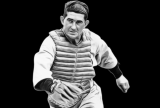
Only seven players have been the starting catcher for as many as three World Series champions. Six of them did it while with the Yankees, Dodgers, or Giants, and then there’s Cochrane, who won two titles with the Athletics and one World Series later as player-manager of the Tigers. He never played on a team that finished lower than third place. He’s also one of only seven players to catch for at least five pennant-winning teams, and the only one who didn’t play for the Yankees or Dodgers.
Mickey was a contact hitter with doubles power. He was remarkably patient, he walked four times as often as he struck out. He usually missed about two weeks each season with an injury, often to his head. He was slow to release the ball, which is why teams ran well against him. But pitchers appreciated throwing to him. “He was the easiest catcher to work with in my career,” Grove said. “Many times he was one step ahead of me on what I wished to do with my pitches.”

Most of you know, I presume, that Baker’s fame was born out of a few clutch home runs he hit in the Fall Classic. You don’t get called “Home Run” for hitting in the regular season. But the most famous play in Baker’s regular season career nearly caused a player revolt in the American League.
Late in the 1909 season during a game in Detroit between the Philadelphia A’s and Tigers, Ty Cobb arrived at third base in a cloud of dirt. Baker had the baseball in his glove when the young Detroit star slid into the bag. After the dust cleared, Baker was on the ground clutching his left arm, the victim of a spike wound. The umpire called Cobb out, but the damage was done, and the A’s bench was in a frenzy. The popular Baker was removed from the game with his injury, and several tense moments ensued at Bennett Park, as players on both benches exchanged words. The normally placid manager of the A’s, Connie Mack, was pretty damn upset too. After the contest, Mack filed a complaint with the league office, appealing to AL President Ban Johnson for justice. Mack called Cobb “the dirtiest player in the game.”
While everyone waited to see what Johnson would do, city officials took action in Philadelphia, passing a resolution that barred Cobb from playing there. Some Philadelphia players threatened to not play the next day if Cobb was in uniform. The Tigers fired back, accusing Baker of blocking the bag, leaving Cobb no choice but to slide into him. The next day, the Detroit News published a photo of the play which clearly showed Baker in front of the bag, reaching across his body to tag Cobb, whose right leg was raised slightly as he slid into third. The photo clearly vindicated Cobb, it was not a dirty play. Johnson took no action against Cobb, but it didn’t soften the animosity between the two teams. The Tigers won their third consecutive pennant that fall, and continued their rivalry with Baker and the A’s, who won pennants in four of the next five seasons.
One of the largest piles of bull you’ll hear from modern baseball fans is this: “Players no longer play the game for the love of it, they’re in it for the money.” Ballplayers have always looked out for their own interests, always angled for the best contract and more money.
In 1914, Connie Mack dismantled his team in part because of the rise of a rival, the Federal League, and in part because of the ominous specter of war in Europe. “I decided to sell out and start over again. When it became known that my players were for sale, the offers rolled into me,” Mack wrote in his autobiography. “If the players are going to ‘cash in’ and leave me to hold the bag, there was nothing for me to do but to cash in too.”
The only star who didn’t jump the team or get sold was Baker, who had a three-year contract, which he tried to renegotiate. Using the leverage of a rival league, Baker demanded more money, but Mack would not budge. The stalemate spilled into the spring of 1915, Baker remaining on his farm in Maryland. “I can stay here and play with the kiddies,” Baker said. And that’s what he did, sitting out the entire 1915 season after having won four straight home run titles. The following year he was sold to the Yankees. Modern players don’t play baseball solely for the love of the game, and neither did Home Run Baker or any of the players in between.

It’s possible that without performance-enhancing drugs, McGwire would have been out of baseball before he hit 300 home runs. Injuries were taking their toll, but the needle ensured his survival. In 1993 and 1994 combined, McGwire hit 18 home runs and played 74 games. He had serious foot injuries, which would have made it hard for him to continue as an everyday player. McGwire’s future was saved by magic beans, and he proceeded to hit 306 home runs after the age of 32.
If you ask McGwire, he never needed steroids. In an interview after he admitted to using PEDs, McGwire said: “I just know myself. I just know. I was [a] born home run hitter. I mean, unfortunately, I did [take PEDs]. And I’ve regretted that. I’ve talked about that. I regretted it. I didn’t need to. That’s the thing. Didn’t need to.” According to Mac, he took steroids to “stay on the field.”
“Unfortunately, there wasn’t any testing,” McGwire continued. “There wasn’t anything going on [to keep the sport clean]. The game has done a terrific job of doing what they’re doing now. I commend them for doing it. I think we all wish [testing] went on when we had played. But unfortunately, it didn’t.”
Well, there you have it. Mark McGwire didn’t need steroids to hit 70 home runs, and had there just been testing in place, he wouldn’t have done them. Damn his luck.

When he retired, Bob Johnson ranked eighth all-time in home runs. Yet, he’s hardly remembered today. The hard-hitting left fielder was an All-Star in eight of his 13 seasons, and received MVP votes in six seasons, including his rookie year and the final year of his career. Denied a spot in the majors until he was 27 years old, the Oklahoma-native stepped into the spot vacated by Al Simmons and had an outstanding rookie campaign for the A’s in 1933, batting .290 with 44 doubles, 21 homers, 93 RBIs, and 103 runs scored. That was just a warm-up for what was to come. From 1935 to 1941, Johnson drove in 100 runs and topped 20 homers every season. He was often the only offensive threat in the weak Philadelphia lineup. He led the team in RBIs for seven consecutive seasons.

In 1911, Waddell was living on a farm in Kentucky when a winter snowstorm caused the Mississippi River to flood. Rube stood in icy water for hours stacking sandbags to combat the flooding, and he caught pneumonia, and eventually tuberculosis. A little over two years later, a weakened Waddell, 70 pounds under his playing weight, died at the age of 38. Upon his death, Harold Skelton of The Sporting News penned an ode:
No more will batters fear his skill, For Rube Waddell is gone;
No more will he mow the batters down, As he always has done;
So, when you talk of Johnson, Wood, Bender and the rest;
Just speak one word for Rube Waddell, When he was at his best.
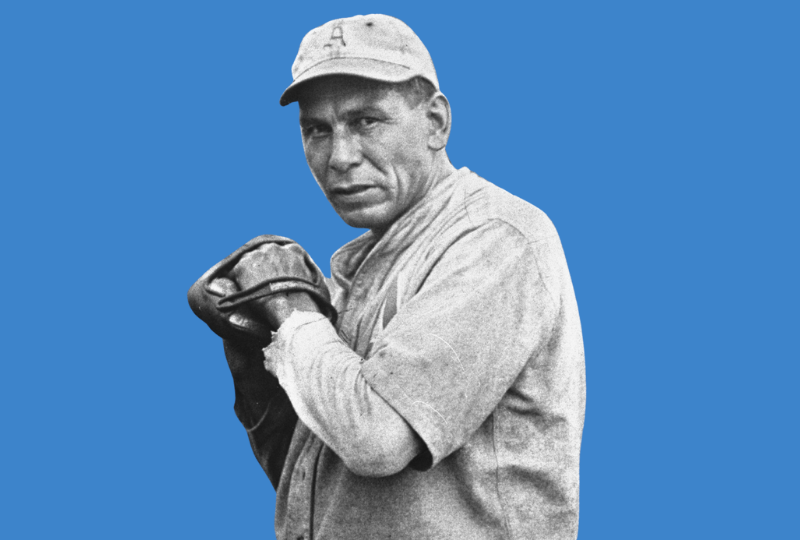
There were a couple dozen pitchers in the deadball era at any one time who were at least as good as Bender. But because he won a lot of games for a great team, Chief ended up with a plaque in Cooperstown.
It’s not a terrible mistake, because famous pitchers who were key to numerous pennant winning teams should be honored in the Hall of Fame. But Bender was not a particularly remarkable performer.
By the way, “Charles” was called “Chief” when he played. By his teammates, by the opposing team, by fans. His friends called him Chief, and without a traumatic result on Mr. Bender’s psyche.
I say that because here we are now in the 21st century and there are those who are washing away history and removing names like “Chief” from the record books. It’s nonsense, of course. Because (1) Bender is not alive to be offended, and (2) he was never offended during his lifetime, and finally (3) as far as we can tell, it was not used to disparage Bender, but to honor him.

“There’s nothing I like better than hitting a ball hard, clean and far. The feel and the sound of it . . . it’s just beautiful. I love putting on that tapered uniform and going out there in front of people.” — Reggie Jackson
“What kind of guy am I? I’m thin-skinned and afraid of being hurt. I’m basically a loner and I sometimes pop off to keep people from getting too close. I’ve hurt a lot of people’s feelings.” — Reggie Jackson

Campaneris was an intense player who used his wits as much as his legs and arms. He was quiet, partially because he was shy by nature, but also because he did not know more than a dozen words of English in his first few years in the United States. In a clubhouse that hosted Reggie and Catfish and Rollie, the Cuban shortstop was seen but rarely heard. Yet his teammates knew how valuable he was, and in eight of his first 11 seasons, Campy received MVP votes. The Athletics made the playoffs five times with him in their lineup, usually as their leadoff man, though he rarely walked.
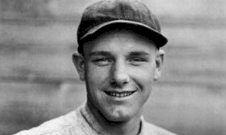
The secret to Rommel’s success as a pitcher was his mastery of trick pitches. He was working as a steamfitter in a shipyard in Maryland during World War I when a coworker showed him how to grip the knuckleball. “The first time I threw it,” Eddie said, “it broke five feet, and I couldn’t stop smiling on the mound.” Less than three years later, Rommel made his big league debut in 1920 with the Philadelphia Athletics. The other pitch Rommel employed most frequently was the spitball, but he became so good at tossing the knuckler that he rarely needed to wet the baseball.
Most baseball historians rate Rommel as the father of the modern knuckleball. He perfected the grip that was later used by Hoyt Wilhelm and Phil Niekro, the most successful practitioners of the butterfly ball. But like most knuckleballers, Rommel had to work hard to tame the pitch and he had frequent stretches when he couldn’t get it to drop. He estimated that he threw the knuckler about 35 percent of the time when he was really going good, and he never had a sore arm.
The A’s corralled several hard throwers in the late 1920s, and Connie Mack put Rommel in the bullpen, but he kept on winning and pitching well. In his last appearance at the age of 34 he entered in relief in the second inning and pitched into the 16th before the A’s managed to win a slugfest. It was his 171st and final victory in major league baseball.
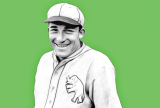
When he played with the Athletics, Al Simmons rented a room in a home that sat across the street from Shibe Park. According to journalist William Nack, Simmons was a late sleeper, and frequently a kid from the neighborhood would be dispatched to wake Al for batting practice. Groggy or not, Simmons was so good, he usually hit the hell out of the ball. He batted .356 in 12 seasons with Philadelphia, and .334 for his Hall of Fame career. He’s on the short list of greatest right-handed hitters in history, but rarely gets mentioned.

Bando was captain of the Oakland A’s when they won five straight division titles and three World Series titles in the 1970s. His temperament was suited for leadership. It was tested by many of his teammates, but “Captain Sal” kept the team on course.
Bando was built like a linebacker and his athletic skills were intuitive. Initially he was a shortstop but the A’s moved him to third to exploit his quarterback arm. Sal soared through the system and was in the majors a year after being drafted. Joe DiMaggio, who was earning a paycheck from the A’s as a roving instructor, raved about Bando. Two years later when the franchise relocated to Oakland, Bando played every game and established himself in the league. He paid attention that first full season, taking notes on pitchers, and in 1969 the scouting paid off when Sal hit 31 home runs and drove in 113. That season he had a .400 on-base percentage on the strength of 111 walks. He was an All-Star for the first of four times, and even better things were yet to come.

A college man, Collins was smart, intuitive, and some would say, scheming. Collins went directly from Columbia University to professional baseball, and he shot quickly to the big leagues, where he was so brash he earned the nickname “Cocky.” He was a baseball nut, loved the game. He was also a tremendous competitor who led six teams to the World Series.
As a player, Collins was fast and athletic with boundless energy. Everywhere Eddie went on a baseball field, he ran. He choked up on the bat and hit the ball to the opposite field more than he pulled it. He was overshadowed as an offensive force because he arrived in the league almost precisely when Ty Cobb and Tris Speaker did. Cobb was born in December of 1886, Collins was born five months later, and Speaker was born the following April. They played in the American League together for 22 years, the last season as teammates.
Collins was fast, maybe not as fast as Cobb, but he stole 81 bases one season, and topped 50 bags six times. He led the league with 42 steals when he was 37 years old. He was a great hitter, not as great as Speaker or Cobb, but good enough to bat .300 18 times. He liked to hang his bats in his barn in the winter to toughen them up. When he was 36 years old, Eddie batted .360 for the White Sox. He liked to bunt, preferring to push the baseball past the pitcher and toward second base, so he could scoot to first before a fielder touched it. He was a good, though not great, defensive second baseman. “He’s the greatest infielder I ever saw,” Connie Mack said, “and he could do everything on a baseball field.”
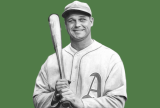
The man they called “Double-X” was very strong, probably the strongest man in baseball prior to the Second World War (outside of maybe Josh Gibson). Jimmie Foxx once hit a home run over the roof and out of the original Comiskey Park. He hit a ball out of Shibe Park straight down the left line. He reportedly hit a ball deep into the upper deck(!) in left field at old Yankee Stadium.

Robert Moses Grove was born in Lonaconing, Maryland, a small town on the Georges Creek Valley in western Maryland. When Robert was only 14 years old he started working in the Dugan Glass factory. All the young boys in Lonaconing did that, until they grew strong enough to work in the mines, which is what Robert’s father did. Baseball saved Robert from having to dip himself deep into the mines: he had such a strong arm that he quit the glass factory when he was 19 to sign with Martinsburg. He was signed to play for Baltimore by Jack Dunn, who had also signed young George Herman “Babe” Ruth years earlier, and which places Dunn near the top of talent evaluators in the history of the game.
Grove’s bread-and-butter, his trademark, was a high “rising” fastball. It didn’t really rise (an overhand pitch can’t rise over 60 feet and six inches), but it sank slower than it had a right to. Lefty could toss his high hard one at the upper limit of the strike zone, which in his day was still the actual letters of the uniform, and hitters couldn’t lay off it. If they hit it at all, they popped it up or pounded it harmlessly into the dirt.
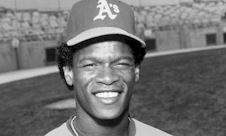
Henderson played for five teams in his last five years, got no serious offers to continue, and played three more years in independent leagues. When he was 45 and 46 years old, he stole 53 bags in 57 tries. He was still drawing walks, he was still touching home plate. Ultimately, in 30 professional baseball seasons, Rickey walked 2,688 times and scored 2,780 runs.
“I was having fun,” Henderson said. “Most people were saying, you know, ‘[Do] you get tired of it?’ But I was having fun because it wasn’t [really about] what are you doing on the field? Were you going out there giving yourself 100 percent and doing the best you can and enjoying it? And when the day is over, you can tip your hat and say I gave you everything I got today. And that’s what kept me going.

This feature list was written by Dan Holmes, founder of Baseball Egg. Dan is author of three books on baseball, including Ty Cobb: A Biography, The Great Baseball Argument Settling Book, and more. He previously worked as a writer and digital producer for the National Baseball Hall of Fame, as well as Major League Baseball Advanced Media.
No reproduction of this content is permitted without permission of the copyright holder. Links and shares are welcome.
No posts found!
6 Comments
Why isn’t Eddie Plank included on your all-time A’s team? I agree that Lefty Grove would be the ace of the starting pitchers, but Plank won close to 300 games for the A’s. As this article points out, he’s the all-time WAR leader for them. Doesn’t he deserve a nod for one of the starting pitchers?
Hi Pat, we acknowledge that Eddie Plank was an excellent pitcher and worthy of the Hall of Fame. But for the A’s All-Time Team, we think mostly modern pitchers were better. Plank pitched a long time ago (his career began nearly 120 years ago). We prefer Lefty Grove, who ranks among the 10-15 greatest pitchers ever, and more modern pitchers such as Vida Blue, Catfish Hunter, and Tim Hudson. We DID select Chief Bender for the A’s All-Time Team, and he was a contemporary of Plank’s, but we think Bender was better at his peak.
Hi Dan, thanks for the reply. Eddie Plank and Charles Bender were contemporaries on the early Philadelphia A’s teams. Comparison of their stats shows them to be very similar in winning percentage and ERA+. However, Eddie Plank pitched 1200 more innings than Bender. I wonder if Bender’s performance would’ve matched Plank’s if he’d pitched those extra innings. Likewise, while Tim Hudson had an excellent winning percentage with the A’s, he only won about 1/3 the games that Plank did. Looking at Bender’s expanded WAR and JAWS (including adjustments to each), as well as WAR 162 and WAA vs. Plank’s show Eddie’s numbers to be better. I know that it’s always “interesting” to compare pitchers of different eras to each other, but the head-to-head of Plank to Bender shows Plank’s numbers to be better.
As a separate thought: your all-time teams show 5 starters and the remainder as relievers. Did you consider having 2 fewer relievers and 2 long relief/swingmen?
Hi Pat, this is a great comment. I agree that the innings is probably why Plank rates ahead of Bender in bWAR.
In regards to the All-Time Teams, I didn’t have a set policy on how I constructed the pitching staffs. In some cases it made sense to put another starter in the pen, because he was clearly one of the best pitchers in team history. I leaned toward that when the pitcher was of the era when starters frequenrly also appeared in relief between starts. Joe McGinnity makes sense as a Giants reliever, for example.
Did you consider having separate all-time teams for franchises that spent time in different cities (Dodgers, Giants, Orioles, Athletics, etc.)? I think that would be cool. In that way, Eddie Plank would be the #2 starter on the Philadelphia A’s team and Iron Man Joe McGinnity would be a starter on the NY Giants team. Just a thought on the all-time team process and selections.
Good idea, Pat. Maybe someday we’ll publish those.